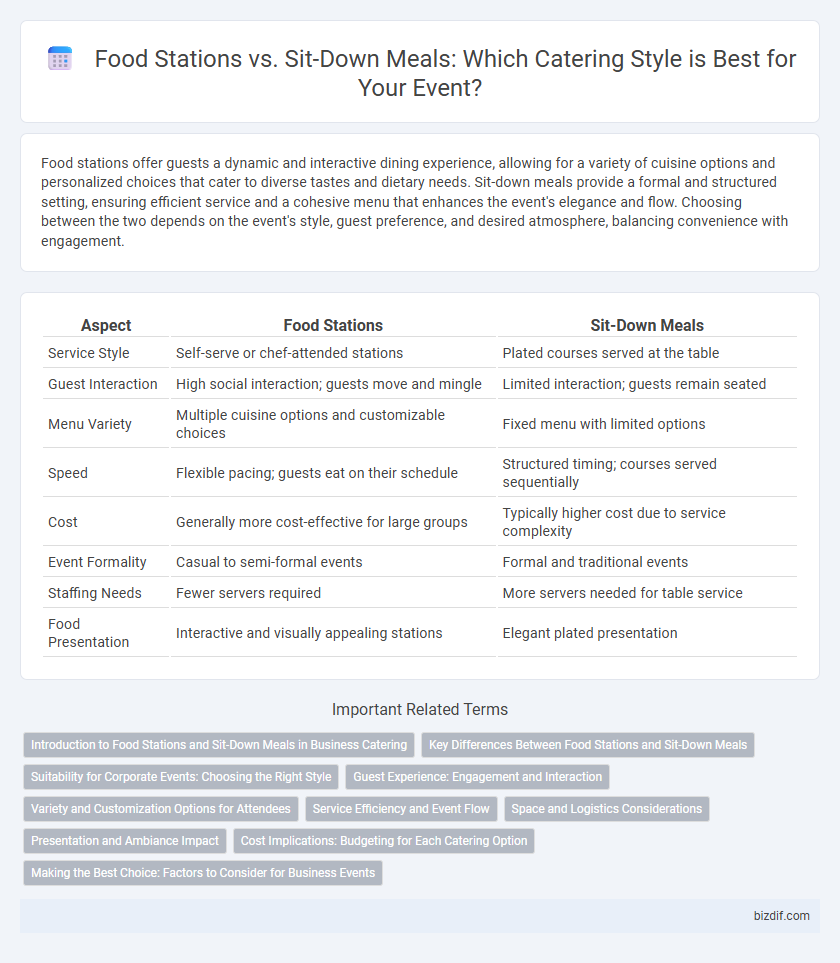Food stations offer guests a dynamic and interactive dining experience, allowing for a variety of cuisine options and personalized choices that cater to diverse tastes and dietary needs. Sit-down meals provide a formal and structured setting, ensuring efficient service and a cohesive menu that enhances the event's elegance and flow. Choosing between the two depends on the event's style, guest preference, and desired atmosphere, balancing convenience with engagement.
Table of Comparison
| Aspect | Food Stations | Sit-Down Meals |
|---|---|---|
| Service Style | Self-serve or chef-attended stations | Plated courses served at the table |
| Guest Interaction | High social interaction; guests move and mingle | Limited interaction; guests remain seated |
| Menu Variety | Multiple cuisine options and customizable choices | Fixed menu with limited options |
| Speed | Flexible pacing; guests eat on their schedule | Structured timing; courses served sequentially |
| Cost | Generally more cost-effective for large groups | Typically higher cost due to service complexity |
| Event Formality | Casual to semi-formal events | Formal and traditional events |
| Staffing Needs | Fewer servers required | More servers needed for table service |
| Food Presentation | Interactive and visually appealing stations | Elegant plated presentation |
Introduction to Food Stations and Sit-Down Meals in Business Catering
Food stations offer a dynamic and interactive dining experience, allowing guests to customize their meals while promoting social engagement, making them ideal for networking events and corporate parties. Sit-down meals provide a structured and formal setting with pre-plated courses, ensuring efficient service and consistent quality, which suits business meetings and conferences. Choosing between food stations and sit-down meals depends on event goals, guest preferences, and logistical considerations in business catering.
Key Differences Between Food Stations and Sit-Down Meals
Food stations offer a customizable, interactive dining experience allowing guests to choose from various options, promoting social mingling and accommodating dietary preferences effectively. Sit-down meals provide structured service with plated courses delivered to each guest, ensuring a formal and elegant atmosphere ideal for events requiring order and timing precision. The choice between food stations and sit-down meals impacts event flow, guest interaction, and service logistics significantly in catering planning.
Suitability for Corporate Events: Choosing the Right Style
Food stations offer a dynamic and interactive dining experience, making them ideal for corporate events that encourage networking and casual mingling. Sit-down meals provide a structured and formal atmosphere, suitable for presentations, award ceremonies, or events where focused attention is required. Selecting the right style depends on the event's goals, guest preferences, and the desired level of engagement among attendees.
Guest Experience: Engagement and Interaction
Food stations create an interactive dining atmosphere by encouraging guests to move around, select personalized dishes, and engage with chefs, enhancing social interaction. Sit-down meals offer a more structured and intimate experience, promoting conversation within smaller groups and a relaxed ambiance. Choosing between the two depends on the desired level of guest engagement and the event's social dynamics.
Variety and Customization Options for Attendees
Food stations offer unparalleled variety and customization, allowing attendees to select from diverse options tailored to dietary preferences and tastes, enhancing guest satisfaction. Sit-down meals provide a structured menu that ensures consistency and quality but limits individual choice and adaptability. Catering with food stations caters to diverse palates and dietary needs more effectively than traditional sit-down formats.
Service Efficiency and Event Flow
Food stations enhance service efficiency by allowing guests to choose and serve themselves, reducing wait times and minimizing bottlenecks compared to sit-down meals. Sit-down meals require coordinated table service, which can slow event flow but offer a structured, orderly dining experience. Optimizing event flow depends on guest volume and event style, with food stations favoring larger, social gatherings and sit-down meals suited for formal, intimate events.
Space and Logistics Considerations
Food stations offer flexibility by requiring less formal seating arrangements, optimizing space in venues with limited room. Sit-down meals demand more structured layouts with adequate space for tables and service staff, impacting guest flow and comfort. Efficient logistics for food stations simplify service and reduce wait times, while sit-down meals necessitate coordinated timing and staffing to ensure seamless course delivery.
Presentation and Ambiance Impact
Food stations offer dynamic presentation with interactive elements, allowing guests to customize their meals while fostering a lively ambiance through social interaction and diverse visual displays. Sit-down meals provide a more formal setting with elegantly plated courses, enhancing the atmosphere with structured pacing and intimate table arrangements ideal for focused conversation. The choice between these formats significantly influences the event's overall vibe, tailoring the experience to either vibrant engagement or refined sophistication.
Cost Implications: Budgeting for Each Catering Option
Food stations typically offer more flexibility and can reduce labor costs by allowing guests to serve themselves, making them a cost-effective choice for larger events. Sit-down meals often require more staff for serving and clearing, increasing overall expenses, but provide a formal dining experience that may justify higher budgets. Event planners should carefully evaluate guest count, service style, and staffing fees to optimize catering budgets for either option.
Making the Best Choice: Factors to Consider for Business Events
Choosing between food stations and sit-down meals for business events depends on factors like guest interaction, event style, and timing. Food stations encourage networking and variety, making them ideal for casual or large gatherings, while sit-down meals offer formal dining experiences suited for presentations or award ceremonies. Budget constraints and service logistics also play critical roles in deciding the most effective catering approach.
Food Stations vs Sit-Down Meals Infographic

 bizdif.com
bizdif.com